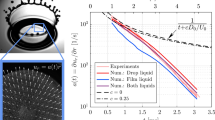Abstract
A viscous fluid separates a massed, sliding, free elliptic plate and a smooth bottom plate. Due to the weight, the gap width between the plates decreases. The increased viscous drag eventually stops the skidding. The Navier-Stokes equations are expanded in terms of a small squeeze number. It is found that the gap width decrease as (time)−1/2 and the maximum skidding distance depends on five nondimensional groups. An example shows it is easier for the elliptic plate to side longitudinally than laterally.
Similar content being viewed by others
References
C.Y. Wang, Int. J. Eng. Sci. 19 (1981) 891.
C.Y. Wang, Phys. Fluids 20 (1977) 164.
Author information
Authors and Affiliations
Rights and permissions
About this article
Cite this article
Wang, C.Y. The skidding of an elliptic plate on a wet surface. Appl. Sci. Res. 42, 201–209 (1985). https://doi.org/10.1007/BF00539340
Issue Date:
DOI: https://doi.org/10.1007/BF00539340




